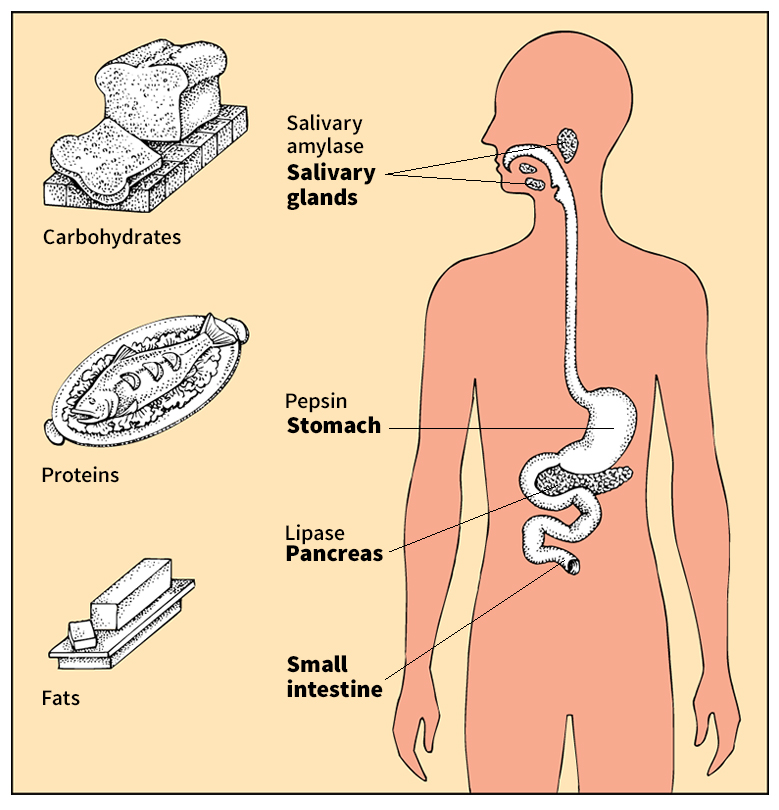Enzyme << EHN zym >> is a molecule that speeds up chemical reactions in all living things. Without enzymes, these reactions would occur too slowly or not at all, and no life would be possible.

All living cells make enzymes, but enzymes are not alive. Enzyme molecules function by altering other molecules. Enzymes combine with the altered molecules to form a complex molecular structure in which chemical reactions take place. The enzyme, which remains unchanged, then separates from the product of the reaction. Enzymes thus serve as catalysts (see Catalysis). A single enzyme molecule can perform its entire function a million times a minute. The chemical reactions occur thousands or even millions of times faster with enzymes than without them. Most enzymes are proteins. A small number of RNA (ribonucleic acid) molecules also function as enzymes.
The human body has thousands of kinds of enzymes. Each kind does one specific job. Without enzymes, a person could not breathe, see, move, or digest food. Photosynthesis in plants also depends on enzymes.
Many enzymes break down complex substances into simpler ones. Others build complex compounds from simple ones. Most enzymes remain in the cells where they were formed, but some enzymes work elsewhere. For example, the pancreas secretes the enzyme lipase, which travels to the small intestine to break down fats.
The word enzyme comes from two Greek words meaning in yeast. Many scientists who studied enzymes in the 1800’s studied reactions caused by yeast enzymes.
An American biochemist, James B. Sumner, was the first person to isolate a pure enzyme in the form of crystals. In 1926, he extracted the enzyme urease from beans and proved that enzymes are protein molecules. In 1969, scientists first chemically synthesized an enzyme, ribonuclease, from amino acids. This enzyme breaks down ribonucleic acid into molecules of other amino acids (see RNA). Today, scientists are trying to make new synthetic enzymes that carry out reactions not found in nature.
Structure.
Enzymes are too tiny to be seen even with the most powerful light microscopes. However, scientists know through various research techniques that enzymes occur in a number of shapes and sizes. Although enzymes of different plants and animals have different protein structures, they function in similar ways. The structure of any particular enzyme enables it to cause chemical reactions in other molecules. Scientists sometimes change the structure of enzyme molecules to study how altered enzymes function or to make enzymes carry out different chemical reactions.
An enzyme’s structure can easily be destroyed by heat, acids, or alkalis. Many deadly poisons act by damaging important enzymes. Hereditary diseases may occur in people born without certain enzymes. These diseases include such brain-damaging disorders as galactosemia and phenylketonuria (PKU). In many cases, tests can detect these enzyme deficiencies. Physicians can sometimes treat them with diet and drugs to prevent deformities, intellectual disability, and even death.
Although most enzymes are proteins, some must be attached to certain nonprotein molecules in order to function. Many of these nonprotein molecules are metals, such as copper, iron, or magnesium. They occur within the body as trace elements (see Trace elements). Others are organic compounds called coenzymes. If a coenzyme is tightly attached to the protein part of the enzyme, the unit is called a prosthetic group. Neither the coenzyme nor the protein part of a prosthetic group can function alone.
Many coenzymes consist of vitamins, especially B vitamins. If a person’s diet lacks adequate amounts of these vitamins, the enzymes cannot function properly, and various body disorders may develop. See Vitamin (How vitamins work).
Uses.
Enzymes have many uses in addition to their natural functions in the body. Manufacturers use enzymes in making a wide variety of products. For example, some detergents contain enzymes that break down protein or fats that cause stains. Enzymes are also used in the manufacture of antibiotics, beer, bread, cheese, coffee, sugars, vinegar, vitamins, and many other products. Physicians use medicines containing enzymes to help clean wounds, dissolve blood clots, relieve certain forms of leukemia, and check allergic reactions to penicillin. Doctors also diagnose some diseases by measuring the amount of various enzymes in blood and other body fluids. Such diseases include anemia, cancer, leukemia, and heart and liver ailments.
In the future, enzymes may be widely used to change raw sewage into useful products. Enzymes also may be used to help get rid of spilled oil that harms lakes and oceans. The enzymes would turn the oil into food for sea plants.
